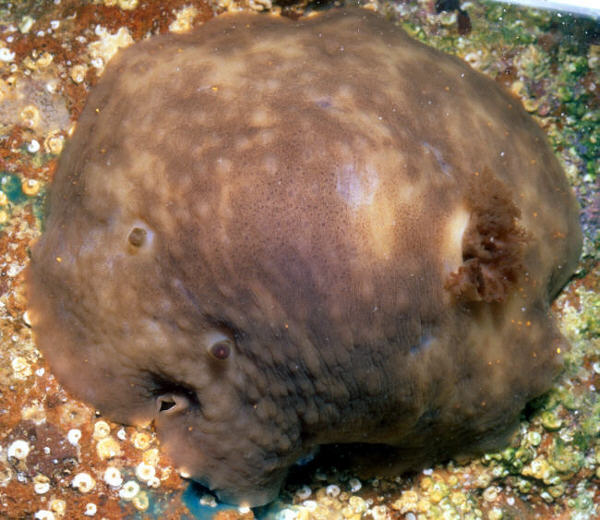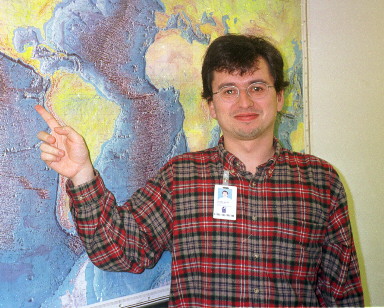 |
Cadlina luarna
Photo courtesy of Angel Valdes and Orso Angulo Campillo
Cadlina luarna, (Marcus & Marcus, 1967)
This is one of the "most wanted" nudibranchs from the Panamic Region. It was described by Marcus & Marcus in 1967 based on two preserved specimens collected by P. Pickens in Puerto Peñasco, Sonora, México. Of course, in the original description there was no data on the external color of the living animals, and the anatomical descriptions were rather poor. Marcus & Marcus (1967) erected the new genus Inuda, based on this species. They didn't have a clue about the "affinities" or relationships of this genus, so they placed it in its own subfamily, Inudinae. Since then, no more specimens of this species have been collected and the taxonomic status of the genus Inuda remained a mystery.
In order to complete a review of the cryptobranch dorid genera I am working on, I needed badly to find some specimens for anatomical studies. My first try was in the Smithsonian Institution in Washington D.C., where the type material was deposited. The type collection consists in only one of the original specimens, so badly preserved and dissected that it is hard to tell whether it is actually a nudibranch. It was completely useless for my research. The other specimen was apparently lost. I asked my friend Dr. Hans Bertsch for some specimens and surprisingly he didn't have any. So I though, if Hans didn't collect this animal in Baja California, that means that it doesn't exist!
I was almost ready to give up and declare Inuda "nomen dubium", which means that the identity of the name couldn't be determined (or in plain English that I didn't know what the heck that animals was), when I went to Baja California with Hans(*). One day Hans, Orso Angulo Campillo and I went diving in Ensenada de los Muertos, southeast of La Paz, Baja California Sur. This is one of Hans' secret localities, a beautiful place that has nothing to do with its name that in English means "Inlet of the Death People". When we came out of the water, Orso had some specimens to show to us, and among them there was this large dorid showed in the picture, which we immediately identified as Inuda luarna. I couldn't believe that after all I was going to be able to study one specimen, when Orso told me that he had a bunch of them in his collection! He also included it in his Bachelor Thesis (Angulo Campillo, 2000). I brought some of the animals to San Francisco and studied them anatomically. The radula and the reproductive system are typical of the genus Cadlina (family Chromodoridiae), and therefore Inuda is a synonym of Cadlina. Mystery solved! Cadlina luarna is however, a valid species, which differs considerably from other members of the genus in several regards. For example, the mantle glands are very small and irregularly arranged, the body is very large and tall, the rachidian teeth have a large central cusp, and the prostate is short and wide. All this features seem to be very plesiomorphic (or primitive), and it is very likely that Cadlina luarna is a very close to the ancestor of all Cadlina. The paper on Cadlina luarna has been published a few weeks ago (Valdés & Angulo Campillo, 2000).
But this story doesn't end here. Last week, Yolanda Camacho, the curator of mollusks in INBio (the National Biodiversity Institute of Costa Rica) came to San Francisco with some photos of nudibranchs collected this year from the Pacific side of her country. One of them was a large specimen of Cadlina luarna. This is a range extension of more than 2,000 miles south-east for this species, and it was too late to add it to the paper! It is amazing, that since 1997 about seven specimens of Cadlina luarna have been collected, a species that was known from only two animals collected in 1967. There is a gap of 30 years in which no specimens of one of the "most wanted" nudibranch from the Panamic Region have been seen.
San Francisco, California
Aug. 2000
(*)Webmaster's Note: For the inside story on the La Paz-Bahia de Los Angeles Field Trip, click here!
Literature cited
Angulo Campillo, O. J. 2000. Moluscos opistobranquios (Mollusca: Opisthobranchiata) de Baja California Sur, México. B.A. Dissertation, Universidad Autónoma de Baja California Sur, La Paz. 176 pp.
Marcus, Ev. and Er. Marcus. 1967. American opisthobranch mollusks. Studies in Tropical Oceanography 6: 1-256, pl. 1.
Valdés, A. and Angulo Campillo, O. J. 2000. Redescription and reassessment of Cadlina luarna (Ev. Marcus and Er. Marcus, 1967), comb. nov. (Mollusca, Opisthobranchia, Doridina). Proceedings of the California Academy of Sciences 52: 77-85.
Taxomonic data courtesy of Angel Valdes

Send Angel mail at avaldes@CalAcademy.org
|
